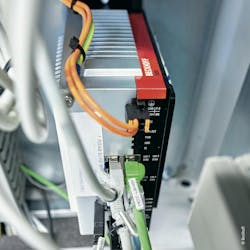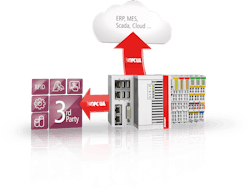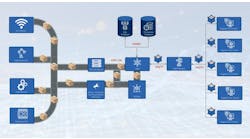The role of OPC UA in HMI, machine learning and simulation
Brandon Stiffler rejoined Beckhoff Automation in July as software product manager with a focus on human-machine interface (HMI), machine learning, simulation and other automation technologies deeply rooted in computer science. Previously an application engineer at Beckhoff, Stiffler spent almost two years as a software development consultant at Levvel, now Endava, and Hylaine (Figure 1).
Stiffler has years of experience with TwinCAT and an understanding of complex industrial automation applications. He will report directly to Director of Product Management Daymon Thompson. Stiffler will work collaboratively with other key members of the team, including Software Product Manager Casey Taylor and Vision Product Manager Todd Jarvey.
“Brandon is an intelligent and forward-thinking automation software pro. We couldn’t be more excited to have him return to Beckhoff,” Thompson said. “He will take charge of TwinCAT HMI, machine learning, measurement and analytics, along with the software’s integration into MatLab/Simulink and other third-party technologies. This comprehensive TwinCAT team today really highlights the rapid expansion of both our software product portfolio and company.”
With Stiffler taking over visualization, simulation and other software technology components, Taylor will spearhead areas of core machine control such as programmable-logic-controller (PLC), fieldbus-communications and other TwinCAT functionality. Jarvey, on the other hand, focuses exclusively on TwinCAT Vision, the fully integrated image processing solution, as well as the company’s forthcoming machine vision hardware.
During the early stages of his career, Stiffler actively pursued a diverse range of experiences within the automation industry, encompassing integration, custom machine building and distribution. His professional journey consistently involved bridging high-level software with control systems, navigating the Microsoft .NET development stack, databases, vision and robotics, in addition to PLC, motion control and HMI programming.
In 2018, Stiffler joined Beckhoff, assuming the role of an application engineer and effectively collaborating with a broad spectrum of clients across the southeastern region. Over the past two years, he has showcased his software development skills as a full-stack web developer.
“Coming back to Beckhoff, I’m excited to see that the welcoming culture and strong leadership haven’t changed, even though there are so many new faces due to our continued growth,” Stiffler said. “Beckhoff is continually at the forefront of the automation industry. Through our approach to PC-based controls and our software architecture, we embrace many leading-edge technologies long before others in our space. With my role being heavily involved with the software and data-focused products, one of the main challenges will be to simply keep up. Our offerings will continue to evolve, and so must we to effectively develop, sell and support them.”
Stiffler earned a bachelor’s degree in computer science from the State University of New York at Fredonia.
What have been the most significant advancements/changes in technology that have affected OPC UA acceptance/implementation in the past five years?
Brandon Stiffler, software product manager, Beckhoff Automation: From the perspective of both original equipment manufacturers (OEMs) and end customers, one of the most significant advancements in OPC UA revolves around its sophisticated information-modeling capabilities. OPC UA boasts more than 80 companion specifications, enabling the mapping of diverse industry- and vendor-specific information models to the OPC UA framework. This capability offers a substantial advantage in client/server environments—that is, it ensures the server's address space is clearly defined and clearly understood by a client.
When an OPC UA server incorporates these types of companion specifications into its address space, machines can identify themselves as specific types, such as a packaging machine. As a result, all connected client applications can effectively interpret and engage with the associated data points. This streamlined approach significantly reduces engineering time and efforts, ultimately leading to cost savings.
What’s the most innovative or efficient OPC UA application you’ve ever seen or been involved with?
Brandon Stiffler, software product manager, Beckhoff Automation: Manz, a leading customer of ours, embraced OPC UA early on and seamlessly integrated it into their laser welding system. Based in Reutlingen, Germany, Manz is a global high-tech engineering company specializing in solutions for electric-vehicle (EV) manufacturing, battery production, electronics, energy and medical technology. Their offerings range from tailored one-off machines for laboratory use to standardized modules and turnkey lines for mass production. With such a broad spectrum of offerings, they need high-performance, extremely flexible automation technology to meet the needs of various industries and, in this case, effectively manufacture lithium-ion battery cells, battery systems and capacitors.
One standout example of its innovation with OPC UA is the Battery Laser System (BLS) 500 (Figure 2). This versatile platform caters to diverse processes in lithium-ion battery manufacturing, including precise laser welding, cutting, drilling and material removal. This system, built on a standardized machine base, functions both as an independent unit for manual workpiece loading and as an integral part of a larger production line.
Manz uses fast EtherCAT communication for the machine processes, linking the industrial PC (IPC) automation controller with EtherCAT-networked terminals and drives, but they also heavily rely on OPC UA for data exchange across the system. Utilizing the TwinCAT 3 OPC UA function (TF6100), they seamlessly transmit camera images to the human-machine interface (HMI), integrate with higher-level systems and facilitate cross-control communication. Even the virtual commissioning tool communicates with the TwinCAT controller via OPC UA.
The breadth of OPC UA integration in their operations is notable. Recognizing the benefits of standardized, secure and vendor-independent communication early on, Manz effectively employs the TwinCAT OPC UA server and client extensively. Today, they route nearly all external communication through OPC UA.
How has OPC UA benefitted from the proliferation of components from multiple suppliers in machinery?
Brandon Stiffler, software product manager, Beckhoff Automation: When the OPC Foundation began working on OPC COM DA—the precursor to OPC UA—in 1994, its primary objective was to establish a standardized communication layer to facilitate interoperability among diverse automation vendors. This objective remains central to OPC UA. Being vendor-neutral, platform-independent and equipped with built-in security and communication patterns, OPC UA effectively addresses various communication scenarios prevalent in modern industrial settings. It particularly shines in environments where equipment comes from different suppliers.
OPC UA can be this common protocol for the manufacturer and machine builder without requiring either to build or maintain a proprietary information model. It's already available, and it just works.
Can you explain how Industry 4.0 initiatives, or the Industrial Internet of Things has impacted the use of OPC UA in manufacturing?
Brandon Stiffler, software product manager, Beckhoff Automation: Easily accessing, processing and making decisions based on real data is critical for any Industrial Internet of Things (IIoT) application. Maybe you’re doing some preprocessing to enhance performance in the field before sending data to a higher level for training machine-learning models. Or maybe you’re a multinational manufacturer who needs to report overall equipment effectiveness (OEE) stats to compare performance across sites to schedule preventive maintenance. OPC UA offers a highly agnostic method of securely sending encrypted data vertically and horizontally. So with many engineers searching for a tool to make these initiatives a reality, it’s no coincidence that OPC UA adoption has increased at the same time.
Do you find OPC UA more useful in small embedded systems of larger cloud-based applications?
Brandon Stiffler, software product manager, Beckhoff Automation: OPC UA serves as a pertinent and valuable communication technology for both embedded systems and cloud systems. In embedded systems, it gathers data through various sources, such as attached sensors or automation controllers. In cloud systems, it offers endpoints for transmitting and subsequently processing the data in storage or analytics services. So it’s less about one being better than the other, and more about understanding how OPC UA can be best implemented for both.
How has the security and scalability of OPC UA made it more user-friendly?
Brandon Stiffler, software product manager, Beckhoff Automation: Often, security measures are perceived as compromising user-friendliness. However, I hold the view that OPC UA's scalability offsets this concern by simplifying the handling of built-in security mechanisms. Users need only understand and work with a single communication technology rather than juggle multiple protocols. Does OPC UA offer sophisticated security mechanisms? Undoubtedly. Does it appear complex initially? Absolutely. Yet, once you’re through the learning curve, it becomes quite manageable.
Moreover, due to its scalability, OPC UA applies these principles uniformly across communication layers, whether that’s between controllers, controller and HMI, controller and cloud or beyond. Additionally, OPC UA introduces supportive mechanisms for managing security operations, such as the Global Discovery Server (GDS). This server furnishes a standardized interface for client/server applications to acquire and update their certificates.
What future innovations will impact the use of OPC UA in manufacturing operations?
Brandon Stiffler, software product manager, Beckhoff Automation: First of all, I think that we will see an increasing number of projects that utilize companion specifications to achieve a standardized and unified communication layer. Furthermore, emerging technologies like the Global Discovery Server (GDS) and the recently introduced OPC UA Publisher/Subscriber communication pattern will expand on the comprehensive offerings of the protocol. This will enhance both functionality and ease of implementation.
Of course, these mechanisms have existed in specifications for several years. Now, vendors need to ramp up their integration into products to make them available to a wider user base. This integration process is ongoing, and it takes time. Consequently, I anticipate that the most innovative projects within manufacturing operations will predominantly rely on these two mechanisms.
Anything else that you’d like to add about OPC UA?
Brandon Stiffler, software product manager, Beckhoff Automation: Not really. It’s a great technology, and it’s been fun to work with. The increasing demand for OPC UA by our customers shows that it is a sought-after technology that’s already in use in nearly every industry.
Tell us about one of your organization’s state-of-the-art OPC-certified products.
Brandon Stiffler, software product manager, Beckhoff Automation: Beckhoff started developing OPC UA-enabled products in 2006. Our pioneering offering, the TwinCAT OPC UA Server, was the very first OPC UA Server integrated into an automation controller. So, it’s a point of pride that we were the first company to launch a ready-to-use product in this domain, and it was the first to receive certification, too. Another point of pride is that this product is still available today.
Customers can use it to facilitate access to variables, structures and methods from the TwinCAT PLC real time via OPC UA. Over the years, The TwinCAT OPC UA Server has evolved significantly. It has incorporated numerous OPC UA functionalities such as data access, method calls, historical access, alarms & conditions and an advanced role-based security model applicable even at the node level. Notably, the TwinCAT OPC UA Server was among the earliest server products on the market to receive certification.








